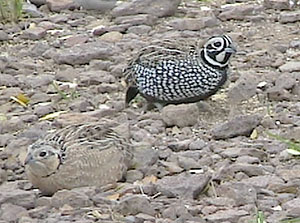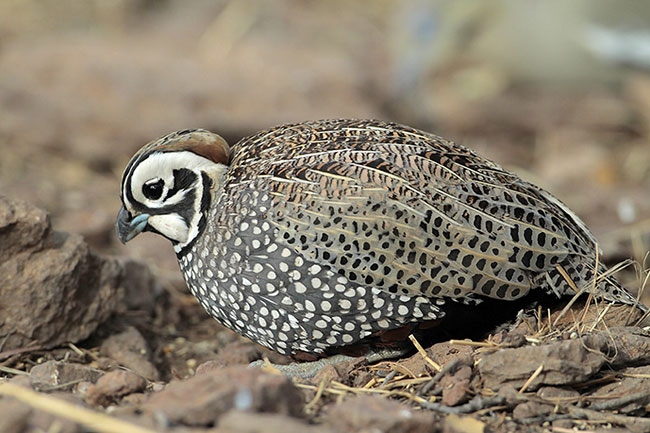With a small U.S. distribution and secretive habits, the Montezuma Quail is often hard for birders to see, though well worth the effort for its beautiful plumage. A bird of arid country, the Montezuma Quail bathes in dust rather than water, although they come to water sources each day to drink.
Montezuma Quail are taken by both Cooper’s Hawks and Northern Goshawks. Winter storms also likely cause mortality. Few Montezuma Quail have been banded, so their lifespan in the wild is unknown, although they have lived up to seven years in captivity.
On this page
Description of the Montezuma Quail
BREEDING MALE
The Montezuma Quail is a chunky quail with a very short tail, rounded wings, and a rounded crest on the head.
-Chestnut belly.
-Gray flanks with white spots.
-Bold black and white face pattern.

Photograph © Sam Crowe
Female
Mostly brownish above and pinkish-brown below.
Seasonal change in appearance
None.
Juvenile
Juveniles resemble females but are heavily mottled with black.
Habitat
Oak canyons and mountain slopes.
Diet
Bulbs, seeds, and insects.
Behavior
Forages on the ground.
Range
Resident in parts of the southwestern U.S. and Mexico.
Fun Facts
Montezuma Quail are secretive and poorly studied.
Males and females pair up for at least the breeding season, but it is unknown if they stay together longer.
Vocalizations
Usually silent, but occasionally produces owl-like or insects-like sounds.
Attracting
Montezuma Quail will come to water sources.
Similar Species
- Male distinctive. Other quail lack the rounded crest.
Nesting
The nest is on the ground with a dome of grass over it.
Number: 10-12.
Color: White.
Incubation and fledging:
– Young hatch at 25-26 days.
– Young fledge (leave the nest) shortly after hatching but remain with the adults for some time.
Distribution of the Montezuma Quail
.
1


